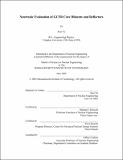Neutronic evaluation of GCFR core diluents and reflectors
Author(s)
Yu, Kun, 1974-
DownloadFull printable version (661.1Kb)
Alternative title
Neutronic evaluation of Gas-Cooled Fast Reactor core diluents and reflectors
Other Contributors
Massachusetts Institute of Technology. Dept. of Nuclear Engineering.
Advisor
Michael J. Driscoll.
Terms of use
Metadata
Show full item recordAbstract
Materials are evaluated for use as in-core diluents and as peripheral reflectors for Gas-Cooled Fast Reactor (GFR) service, using coupled Monte Carlo (MCNP) and isotopics (ORIGEN) codes. The principal performance indices compared were effects on beginning of irradiation multiplication factor, reactivity-lineated burnup, and coolant (here CO2) void reactivity. While low values of the macroscopic absorption cross section, [Sigma]a, and slowing down power, [xi] [Sigma]s, are qualitatively useful predictors of good performance, it was found that only full scope calculations were valid for quantitative assessment. For example, several materials (Ni, Nb) having poor performance as in-core diluents proved to be good reflectors. Many materials which reduced coolant void reactivity also proved detrimental to reactivity lifetime. Others, mostly the strong moderators, increased initial reactivity, but decreased reactivity lifetime. Cores fueled with plutonium exhibited a much larger void reactivity than those started up using U-235 as the fissile material. While there are no ideal candidates that are superior in all respects, considering only neutronic performance, the following appear worthy of further investgation: Metallic fuel diluents or matrices (eg. CERMET or METMET): Zr, Ti, V, Ba2Pb; High temperature fuel diluents or matrices (eg, CERMET, CERCER): SiC, BaS Cladding: Fe alloys with Cr, Al (eg ODS) Reflector: Zr3Si2, Pb, Ba2Pb, ZrS2, MoSi2 plus a variety of sulfides and silicides.
Description
Thesis (S.M.)--Massachusetts Institute of Technology, Dept. of Nuclear Engineering, 2003. Includes bibliographical references (p. 67-68). This electronic version was submitted by the student author. The certified thesis is available in the Institute Archives and Special Collections.
Date issued
2003Department
Massachusetts Institute of Technology. Department of Nuclear Engineering; Massachusetts Institute of Technology. Department of Nuclear Science and EngineeringPublisher
Massachusetts Institute of Technology
Keywords
Nuclear Engineering.